October itinerary in Japan Day 8 (Hyogo Day 2 Meal edition)
(Wednesday, October 27)
Table of contents
1. Osakana Kyowakoku (Fish Republic) Ebisu Maru
1. Osakana Kyowakoku (Fish Republic) Ebisu Maru
I ate “Raw Shirasu (whitebait) Don and Grilled Spanish Mackerel Don” (Yen950) at “Osakana Kyowakoku (Fish Republic) Ebisu Maru” at Road Station “Awaji”. Both raw shirasu and Spanish mackerel are specialties of Awaji Island. Awaji Island’s raw shirasu (season is May-November) and Awaji Island’s Spanish mackerel (season is September-November) are selected by Japan Fisheries Cooperatives as “PRIDE FISH” in summer and autumn in Hyogo Prefecture. It was a very luxurious experience to be able to eat both “PRIDE FISH” selected from Awaji Island in one bowl. Especially, the raw shirasu was excellent. If possible, I wanted to eat the Spanish mackerel as raw, not roasted.
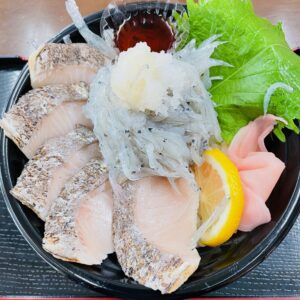
2. Michi no Ekinaka Shokudo
“Raw Shirasu (whitebait) Don and Grilled Spanish Mackerel Don” of “Osakana Kyowakoku (Fish Republic) Ebisu Maru” was very delicious and very satisfying, but I was hungry because the amount was a little small. Therefore, I wanted to eat the sashimi of red sea bream, which is a specialty of Awaji Island facing the Akashi Strait and Naruto Strait, so I had a small “Red sea bream and raw egg on rice” (Yen580) at “Michi no Ekinaka Shokudo”. “Michi no Ekinaka Shokudo” is a cafeteria that locals also go to, offering various set meals in addition to fish and shellfish.
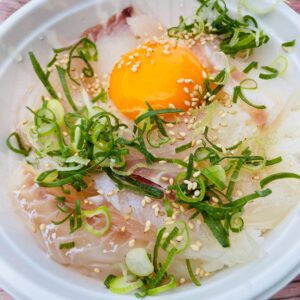
I could have eaten outside at “Osakana Kyowakoku (Fish Republic) Ebisu Maru”, but I ate inside the store, so this time I ate outside while looking at the Akashi Kaikyo Bridge. “Red sea bream and raw egg on rice” was the best taste because the sashimi with the crunchy texture of the sea bream, the sticky raw egg and the delicious soup stock were exquisitely entwined. The price is reasonable and recommended.
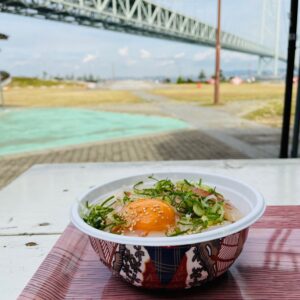
The brand “Awajishima Ebisu Sea Bream” was born just this fall, and they are trying to boost the branding of sea bream as all Awajishima.
3. Craft beer
Craft beer “AWAJI BEER” is also sold at the roadside station “Awaji” shop. “AWAJI BEER” is a well-known craft beer that is also sold in Tokyo. I drank “Pale Ale”. The beer I drank while looking at the Akashi Kaikyo Bridge was the best.
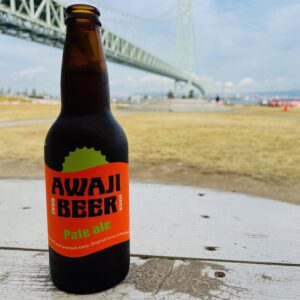
4. Takoiso
After visiting the Sun Yat-sen Memorial Hall in Maiko Park, I moved to Akashi Station and ate Akashiyaki at “Takoiso”. In Akashi, Akashiyaki is called Tamagoyaki. Tamagoyaki has been eaten since the end of the Edo period and is said to have the roots of takoyaki in Osaka. In addition, the Ministry of Agriculture, Forestry and Fisheries has selected Akashiyaki (Tamagoyaki) as a “Local dishes loved by the nation” in Hyogo Prefecture.
The difference from takoyaki in Osaka is that the dough is very soft and you can eat it with soup stock. Therefore, unlike takoyaki, you rarely eat while walking. I prefer Akashiyaki (Tamagoyaki).

At “Takoiso”, I ate a Tamagoyaki of octopus and conger eel (15 pieces for Yen1,100). Normally, only octopus is added to Akashiyaki (Tamagoyaki), but I wanted to try what it tastes like when I add conger eel, which is also a specialty of Akashi. When I tried it, it was excellent. I could feel the taste of octopus and conger eel well, and it was very delicious.
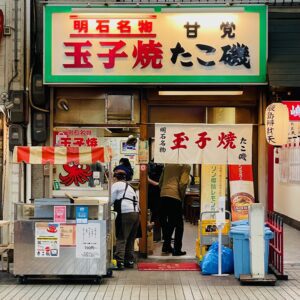
“Takoiso” is located in “Uo no Tana Shopping Street“. It is said that “Uo no Tana Shopping Street” was born with the construction of Akashi Castle (1619). It is said to have been built by Miyamoto Musashi, who planned the city of Akashi. Locally, “Uo no Tana” is pronounced “Uontana”. There are about 10 Akashiyaki (Tamagoyaki) shops in the “Uo no Tana Shopping Street”. I think it’s fun to eat and compare.
5. Akashi-tei Uo no Tana
I wanted to eat Akashi’s specialty sashimi, so I ate sashimi at “Akashi-tei Uo no Tana” in “Uo no Tana Shopping Street”. I ordered the sashimi of “Akashi’s specialty three kinds (sea bream, octopus, and conger eel)” and steamed conger eel. “Three kinds of Akashi specialties” were all exquisite. Especially, the sea bream was delicious. I preferred steamed conger eels to sashimi. After all big conger eel is fatty and delicious. As I explained before, conger eels with a large size of 300g or more are called “Densuke Anago (conger eels)” in Hyogo prefecture.
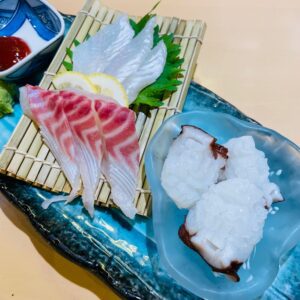
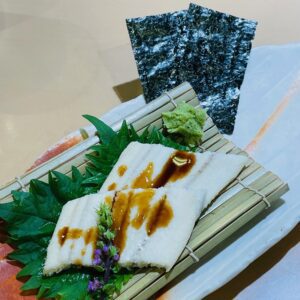
I also ordered conger eel bone sake. I have drank blowfish, sea bream, and rock fish bone sake, but this was the first time I had conger eel bone sake.
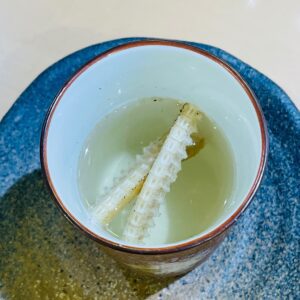
6. Sandaya
I ate steak at Sandaya in Kobe Harborland. Kobe beef steak is included in the “Local dishes loved by the nation” of Hyogo prefecture selected by the Ministry of Agriculture, Forestry and Fisheries, so I wanted to eat Kobe beef steak, although it is luxurious. However, unfortunately, there was no Kobe beef steak at Sandaya on the day I visited. I couldn’t help it, so I ordered a domestic beef steak.

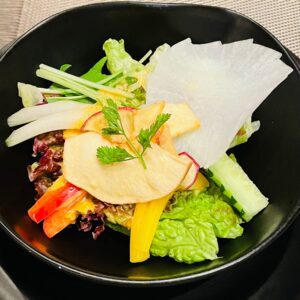
I have eaten at Mitaya several times. As I always think, the dressing on Sandaya’s ham and sliced onions is excellent. The domestic beef steak was more delicious than I had imagined and I was very satisfied.
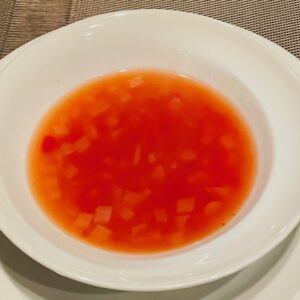
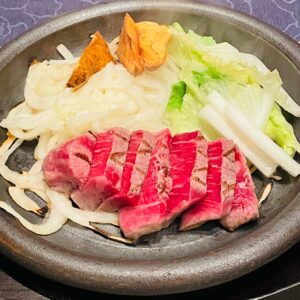
After having a meal at Mitaya, I returned to Tokyo by Shinkansen. During this trip to Hokuriku and Kinki, I was able to eat many seasonal seafood and local dishes. It was a very satisfying trip with only very delicious meals. I would like to recommend everyone to travel to Hokuriku and Kinki regions in October.
Note: The departure / arrival times, fees, admission fees, etc. of transportation listed in the text are as of the time of writing the BLOG. They may change in the future, so please check for yourself when you go on a trip.